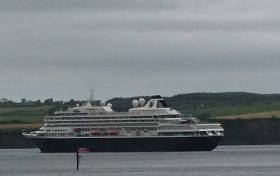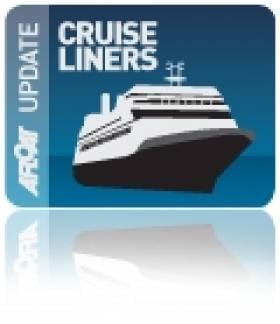Displaying items by tag: HAL
'Elegant Explorer' Makes Final Nostalgic Calls to Irish Ports Including Anchorage off Foynes Island
A luxury cruiseship nickmamed the 'Elegant Explorer' celebrated its final call to Foynes, Co. Limerick by anchoring off the port on the Shannon Estuary.
The call of Prinsendam operated by Holland America Line was according to SFPC a welcome tourism boost for the mid-west region as cruise passengers arrived by tender to visit Foynes (via Foynes Yacht Club). The unique event to anchor off Foynes Island took place on June 13th.
Prinsendam was making a nostalgic call after a career spanning 17 years sailing around the world under HAL colours. Afloat adds the ship was sold to German cruise company Phoenix Reisen and the acquistion actually took place last year. This saw the 37,938grt chartered back to HAL until expiring next week (Monday, July 1st).
The 204m ship with a capacity for 800 passengers took anchorage at 6.30am off Foynes Island and remained for 12 hours during. Hundreds of tourists were tendered ashore to visit the west Limerick town and attractions beyond among them west Clare and to Dingle in neighbouring Kerry.
Approximately 100 passengers stayed local, making their way to Foynes village where they enjoyed the must-loved, award winning Foynes Flying Boat & Maritime Museum.
Shannon Foynes Port Company (SFPC) CEO, Pat Keating said they were delighted to facilitate the cruise ship in the busy port. “We’ve had cruise ships dock in Foynes before but this is the first time a cruise vessel anchored specifically off Foynes Island. Passengers ferried by tender to the pontoon at Foynes Yacht Club where they boarded coaches for various destinations or simply enjoyed Foynes itself on foot. “It delivered a really nice tourism boost for the area, with the passengers visiting Limerick, Clare and Kerry. It was great to see the Flying Boat & Maritime Museum getting an extra boost. It’s a fantastic tourism attraction and deserves as much recognition as it can get and all those who visited it will pass on the good word about it.”
Mr Keating added that while cargo is the core activity, the port authority was delighted to welcome this business. “It was a busy morning and the cruise ship brought a great buzz to the area. From an operational perspective, all passengers were transferred safely and comfortably to and from the vessel. “By anchoring at Foynes Island, cruise liners can easily be accommodated at Foynes as it gives us more capacity in addition to the actual docks itself. Hopefully we will get to welcome many more cruise vessels to Foynes.”
Despite the relatively small size of Prinsendam and low height the cruiseship has during a career dating to 1988 (Afloat will have more) been able to navigate interesting routes where most other such ships cannot. The most recent voyages have included the Amazon, the Caribbean, South America, Antartica and now finally Europe where the ship with a crew of 340 will spend this week with the HAL fleet.
The last voyages include the Mediterranean, Iberian Peninsula, British Isles, Ireland before making her final farewell on a 14-day expedition to the Norwegian North Cape.
Another cruiseship is scheduled to dock on the Shannon Estuary next week on Friday, July 5th.
Not One Not Two but Three Cruise Callers to Cork
Next in terms of tonnage is Holland America Line's near 60,000 tonnes Rotterdam, for more about the 1997 built click this LINK. The final member of the trio belongs to Saga Cruises subsidiary Spirit of Adventure cruises, the 10,000 tonnes Spirit of Adventure. For a visual virtual tour of the vessels interior facilities click HERE.
Spirit of Adventure was scheduled in late April on a 14-day 'Relics of Rome' cruise which was to include ports of call to Libya, Tunisia and Egypt but this was cancelled due to the political situation throughout North Africa.
The combined cruise calls to Cork Harbour has a potential capacity of 5,200 passengers and the mid-July arrival confirms the ports popularity which is to welcome this year a total of 54 cruiseships and over 100,000 passengers. Azura and Spirit of Adventure are to share the berth at Ringaskiddy while the Rotterdam is to berth at the dedicated cruise terminal in Cobh.






























































